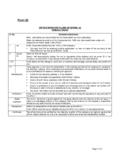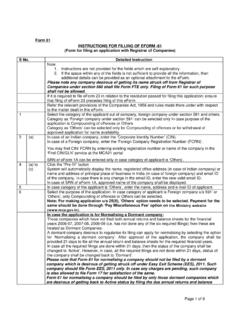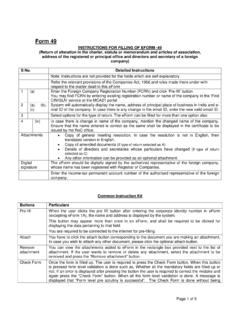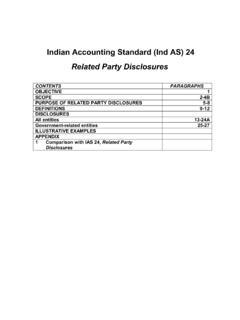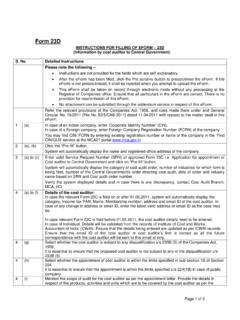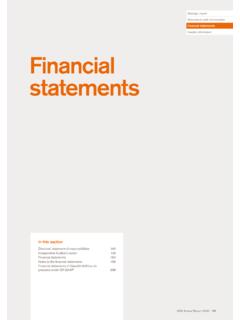Transcription of Consolidated Financial Statements Contents
1 332 Accounting Standard (AS) 21 Consolidated Financial Statements ContentsOBJECTIVE SCOPE Paragraphs 1-4 DEFINITIONS 5-6 PRESENTATION OF Consolidated Financial Statements 7-8 SCOPE OF Consolidated Financial Statements 9-12 CONSOLIDATION PROCEDURES 13-27 ACCOUNTING FOR INVESTMENTS IN SUBSIDIARIES IN A PARENT S SEPARATE Financial Statements 28 DISCLOSURE 29 TRANSITIONAL PROVISIONS30 Consolidated Financial Statements 307 Accounting Standard (AS) 21 Consolidated Financial Statements1(This Accounting Standard includesparagraphsset inbolditalic typeand plain type, which have equal authority.)
2 Paragraphs in bold italic typeindicate the main principles. This Accounting Standard should be read inthe context of its objective and the General Instructions contained in part A of the Annexure to the Notification.) Objective The objective of this Standard is to lay down principles and procedures for preparation and presentation of Consolidated Financial Financial Statements are presented by a parent (also known asholding enterprise) to provide Financial information about the economicactivities of its group. These Statements are intended to present financialinformation about a parent and its subsidiary(ies) as a single economic entityto show the economic resources controlled by the group, the obligations ofthe group and results the group achieves with its resources. Scope 1. This Standard should be applied in the preparation and presentationof Consolidated Financial Statements for a group of enterprises under thecontrol of a parent.
3 2. This Standard should also be appliedin accountingforinvestmentsin subsidiaries in the separate Financial Statements of a In the preparation of consolidatedfinancial Statements , otherAccounting Standards also apply in the same manner as they apply to the separate1It is clarified that AS 21 is mandatory if an enterprise presents Consolidated Financial Statements . In other words, the accounting standard does not mandate an enterprise topresent Consolidated Financial Statements but, if the enterprise presents consolidatedfinancial Statements for complying with the requirements of any statute or otherwise, itshould prepare and present Consolidated Financial Statements in accordance with AS 334 AS 21financial This Standard does not deal with:(a) methods of accounting for amalgamations and their effects onconsolidation, including goodwill arising on amalgamation (seeAS 14, Accounting for Amalgamations); (b) accounting forinvestments in associates (at present governed by AS 13, Accounting for Investments2 ); and (c) accounting forinvestments in joint ventures (at present governed by AS 13, Accounting for Investments3 ).
4 Definitions 5. For the purpose of this Standard, the following terms are used withthe meanings specified: Control: (a) the ownership,directlyorindirectlythrough subsidiary(ies),of more than one-half of the voting power of an enterprise;or (b) control of the composition of the board of directors in thecase of a company or of the composition of the correspondinggoverning body in case of any other enterprise so as to obtaineconomic benefits from its activities. A subsidiary is an enterprise thatis controlled byanotherenterprise(known as the parent). A parent is an enterprise thathas one A group is a parentand allits Consolidated financialstatementsare thefinancialstatements of a2 Accounting Standard (AS) 23, Accounting for Investments in Associates inConsolidated Financial Statements , specifies the requirements relating to accounting for investments in associates in Consolidated Financial Statements .
5 3 Accounting Standard (AS) 27, Financial Reporting of Interests in Joint Ventures , specifies the requirements relating to accounting for investments in joint ventures.. Consolidated Financial Statements 335 group presented as those Equity is the residual interest in the assets of an enterprise after deducting all its Minority interest isthatpartofthe netresults ofoperations and of the net assets of a subsidiary attributable to interests which are notowned, directly or indirectly through subsidiary(ies), by the Consolidated Financial Statements normally include Consolidated balance sheet, Consolidated statement of profit and loss, and notes , otherstatements and explanatory material that form an integral part cash flow statement is presented in case a parent presents itsown cash flow statement. The Consolidated Financial Statements arepresented, to the extent possible, in the same format as that adopted by theparent for its separate Financial Statements .
6 Explanation: All the notes appearing in the separate Financial Statements of theparent enterprise and its subsidiaries need not be included in the notes tothe Consolidated Financial Statements . For preparing consolidatedfinancial Statements , the following principles may be observed inrespect of notes and other explanatory material that form an integral partthereof: (a) notes which are necessary for presenting a true and fair view of the Consolidated Financial Statements are included in the Consolidated Financial Statements as an integral part thereof. (b) Only the notes involving items which are material need to be disclosed. Materiality for this purpose is assessed in relation to theinformation contained in Consolidated Financial Statements . In viewof this, it is possible that certain notes which are disclosed inseparate Financial Statements of a parent or a subsidiary would notbe required to be disclosed in the Consolidated Financial statementswhen the test of materiality is applied in the context of consolidatedfinancial Statements .
7 (c) Additional statutory information disclosed in separate financialstatements of the subsidiary and/or a parent having no bearingon the true and fair view of the Consolidated Financial Statements 336 AS 21need not be disclosed in the Consolidated Financial Statements . An illustration of such information in the case of companies is attached to the Standard. Presentation of Consolidated Financial Statements 7. A parent which presents Consolidated Financial Statements should present these Statements in addition to its separate Financial Statements . 8. Users of the Financial Statements of a parent are usually concerned with, and need to be informed about, the Financial position and results ofoperations of not only the enterprise itself but also of the group as a need is served by providing the users - (a) separate Financial Statements of the parent; and (b) Consolidated Financial Statements , which present financialinformation about the group as that of a single enterprise withoutregard to the legal boundaries of the separate legal entities.
8 Scope of Consolidated Financial Statements 9. A parent which presents Consolidated Financial Statements shouldconsolidate all subsidiaries, domestic as well as foreign, other thanthose referred to in The Consolidated Financial Statements are prepared on the basis of Financial Statements of parent and all enterprises that are controlled by theparent, other than those subsidiaries excluded for the reasons set out inparagraph 11. Control exists when the parent owns, directly or indirectlythrough subsidiary(ies), more than one-half of the voting power of anenterprise. Control also exists when an enterprise controls the compositionof the board of directors (in the case of a company) or of the correspondinggoverning body (in case of an enterprise not being a company) so as to obtaineconomic benefits from its activities. An enterprise may control thecomposition of the governing bodies of entities such as gratuity trust, providentfund trust etc.
9 Since the objective of control over such entities is not toobtain economic benefits from their activities, these are not considered forthe purpose of preparation of Consolidated Financial Statements . For thepurpose of this Standard, an enterprise is considered to control the composition Consolidated Financial Statements 337 of: (i) the board of directors of a company,ifithasthepower, without the consent or concurrence of any other person, to appoint orr e m o v e a l l o r a m a j o r i t y o f d i r e c t o r s o f t h a t c o m p a n y. Anenterprise is deemed to have the power to appoint a director, ifany of the following conditions is satisfied: (a) a person cannot be appointed as director without the exercise in his favour by that enterprise of such a power as aforesaid; or (b) a person s appointment as director follows necessarily from his appointment to a position held by him in that enterprise; or (c) the director is nominated by that enterprise or a subsidiary thereof.
10 (ii) the governing body of an enterprise that is not a company, if ithas the power, without the consent or the concurrence of anyother person, to appoint or remove all or a majority of membersof the governing body of that other enterprise. An enterprise isdeemed to have the power to appoint a member, if any of thefollowing conditions is satisfied: (a) a person cannot be appointed as member of the governing body without the exercise in his favour by that other enterprise of such a power as aforesaid; or (b) a person s appointment as member of the governing bodyfollows necessarily from his appointment to a position heldby him in that other enterprise; or (c) the member of the governing body is nominated by that other enterprise. Explanation: It is possible that an enterprise is controlled by two enterprises onecontrols by virtue of ownership of majority of the voting power of thatenterprise and the other controls, by virtue of an agreement or otherwise,the composition of the board of directors so as to obtain economicbenefits from its activities.
